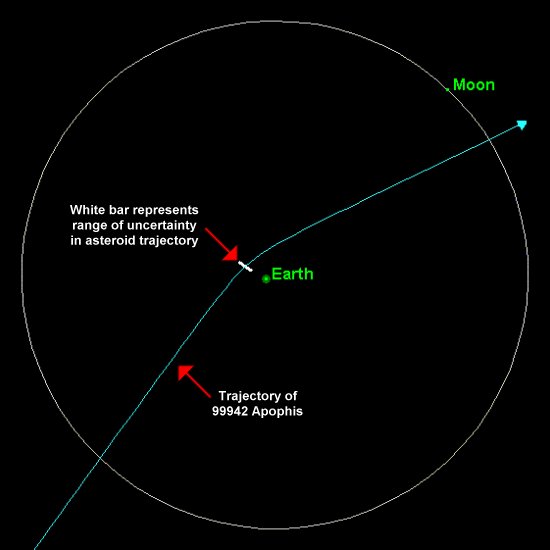Page 2 of 2
Re: Roscosmos is planning to deflect 2004 MN4 asteroid
Posted: Mon Jan 18, 2010 1:06 pm
by neufer
http://en.wikipedia.org/wiki/99942_Apophis wrote:
<<On
Friday, April 13, 2029, [the 350 meter wide] Apophis will pass Earth within the orbits of geosynchronous communication satellites.
This 2029 pass will actually be much closer than the first predictions, but the uncertainty is such that an impact is ruled out.
Close approach of Apophis on Friday, April 13, 2029

Similarly, the pass on [
Easter Sunday] April 13, 2036 carries little risk of an impact.

>>
Re: Roscosmos is planning to deflect 2004 MN4 asteroid
Posted: Tue Jan 19, 2010 1:18 pm
by makc
So, wait,
neufer wrote:
will it hit Venus instead?
Re: Roscosmos is planning to deflect 2004 MN4 asteroid
Posted: Tue Jan 19, 2010 3:30 pm
by neufer
makc wrote:So, wait,
neufer wrote:
will it hit Venus instead?
No: Both Apophis & Venus have orbital inclinations of about 3.33º but...
they are cocked in nearly opposite directions and thus miss by ~ 0.1 radians ~ 10 million kilometers.
Note, however:
Code: Select all
2921 days = 13 Venus orbits of 224.7 days
2912 days = 9 Apophis orbits of 323.587 days
so Venus may well be responsible for defining the current Apophis orbit.
After the 2029 close Earth/Moon encounter Apophis will have a slightly shorter orbit:
Code: Select all
2556.8 days = 7 Earth orbits of 365.256 days
2556.8 days = 8 Apophis orbits of ~319.6 days
The previous uncertainty of the
post 2029 Apophis orbital period
was probably the main concern about the Easter Sunday 2036 encounter.
Re: Roscosmos is planning to deflect 2004 MN4 asteroid
Posted: Tue Jan 19, 2010 4:45 pm
by makc
it would be nice if it hit something... like Venus... or moon... so we wouldn't have to worry about it coming here in another 2XXX.
Re: Roscosmos is planning to deflect 2004 MN4 asteroid
Posted: Tue Jan 19, 2010 5:10 pm
by neufer
makc wrote:it would be nice if it hit something... like Venus... or moon... so we wouldn't have to worry about it coming here in another 2XXX.
Think of it as an amateur astronomy event:
http://en.wikipedia.org/wiki/99942_Apophis wrote:
<<Apophis’s 2029 brightness will peak at magnitude 3.3, with a maximum angular speed of 42° per hour.
The maximum apparent angular diameter will be ~2 arcseconds [i.e., about the size of Neptune but 50 times brighter].>>
Re: Apophis - Amatuers Needed!
Posted: Tue Jun 18, 2013 12:37 pm
by mjimih
http://www.washingtonpost.com/national/ ... story.html
White House, NASA want help hunting asteroids
Published: June 17 2013
The White House and NASA on Tuesday will ask the public for help finding asteroids that potentially could slam into the Earth with catastrophic consequences.
Citing planetary defense, the administration has decided that the search for killer rocks in space should be the latest in a series of “Grand Challenges,” in which the government sets an ambitious goal, helps create public-private partnerships and sometimes offers prize money for innovative ideas.
“This is really a call to action to find all asteroid threats to human populations and know what to do about them,” NASA Deputy Administrator Lori Garver said Monday. She said the asteroid hunt would help prove that “we’re smarter than the dinosaurs.”
There is a second, overlapping agenda at work here: The NASA human spaceflight program needs to find a target rock for what is now being called the Asteroid Redirect Mission (formerly the Asteroid Retrieval Mission), or ARM.
The proposed mission, which is early in the planning stages, would send astronauts to visit an asteroid that had been redirected into a high lunar orbit. But first a robotic spacecraft would have to rendezvous with the asteroid and capture it. And even before that, scientists would have to find the right asteroid.
The target rock has to be moving at a leisurely pace relative to the Earth, and ideally would come close to the Earth-moon system sometime in the early 2020s. At present, NASA has a short list of possible targets, but all need further scrutiny to see if they have the size, shape, spin rate and composition that the asteroid mission would require.
Two recent feasibility studies used as their reference a rock discovered in 2009, but NASA scientists aren’t sure that it will meet the mission requirements. For one thing, it might turn out to be too small. They plan to study it this fall with the Spitzer Space Telescope. ...
Serious enough to feel the need to enlist the public, is getting pretty serious. A call to arms, to save humanity!

>>
